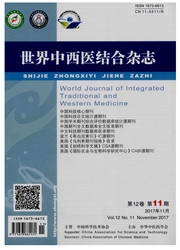

 中文摘要:
中文摘要:
目的观察中医“治未病”综合干预措施对体检心理性亚健康患者症状自评量表(SCL-90)的影响。方法将符合纳入标准的100例心理性亚健康患者按照随机原则分为干预组和对照组,干预组50例,给予中医健康宣传、针灸、拔罐、药茶、药膳等中医“治未病”综合干预措施。对照组50例,给予常规干预措施。6个月后观察对于SCL-90的影响。结果对照组干预后焦虑、偏执指标较干预前有显著改善,差异具有统计学意义(P〈0.01);其他指标比较差异无统计学意义(P〉0.05)。干预组干预后各项指标与干预前比较均有明显改善,尤其是躯体化、抑郁、焦虑、精神病性四项指标差异显著(P〈0.01)。干预组干预后躯体化、抑郁、焦虑、精神病性四项指标与对照组比较,差异具有统计学意义(P〈0.01)。结论中医“治未病”综合干预措施对心理性亚健康患者有很好的疗效,操作简便,患者依从性较高,值得在临床推广。
 英文摘要:
英文摘要:
Objective To observe the impacts on SCL -90 in the patients with psychological pre - clinical disorders treated with the comprehensive intervention of Chinese medicine based on" Disease Preven- tion" theory. Methods One hundred cases of psychological pre - clinical disorders that met the inclusive standard were randomized into an intervention group and a control group. Fifty cases in the intervention group were treated with healthy training, acupuncture, moxibustion, cupping, herbal tea, herbal die and the others based on" Disease Prevention"of Chinese medicine. Fifty cases in the control group, the conventional inter- ventions were given. The impacts on symptom checklist - 90 ( SCL - 90 ) were observed 6 months later. Re- suits The scores of anxiety and paranoid in the control group were improved significantly after intervention as compared with those before intervention, indicating the significant difference (P 〈 O. 01 ), but the differ- ences in the other indicators were not significant( P 〉 0.05). Every indicator was improved obviously after in- tervention as compared with that before intervention in the intervention group. Especially, the differences in somatization, depression, anxiety and psychoticism were significant ( P 〈 0.01 ). The differences in somatiza- tion, depression, anxiety and psychoticism after intervention in the intervention group were significant as com- pared with those in the control group (P 〈0. 01 ). Conclusion The comprehensive intervention of Chinese medicine based on" Disease Prevention" theory achieves the very good efficacy on psychological pre - clinical disorders in the patients. This therapy is simple in operation and high in patient's compliance. Hence, this therapy deserves to be promoted in clinical practice.
 同期刊论文项目
同期刊论文项目
 同项目期刊论文
同项目期刊论文
 期刊信息
期刊信息
